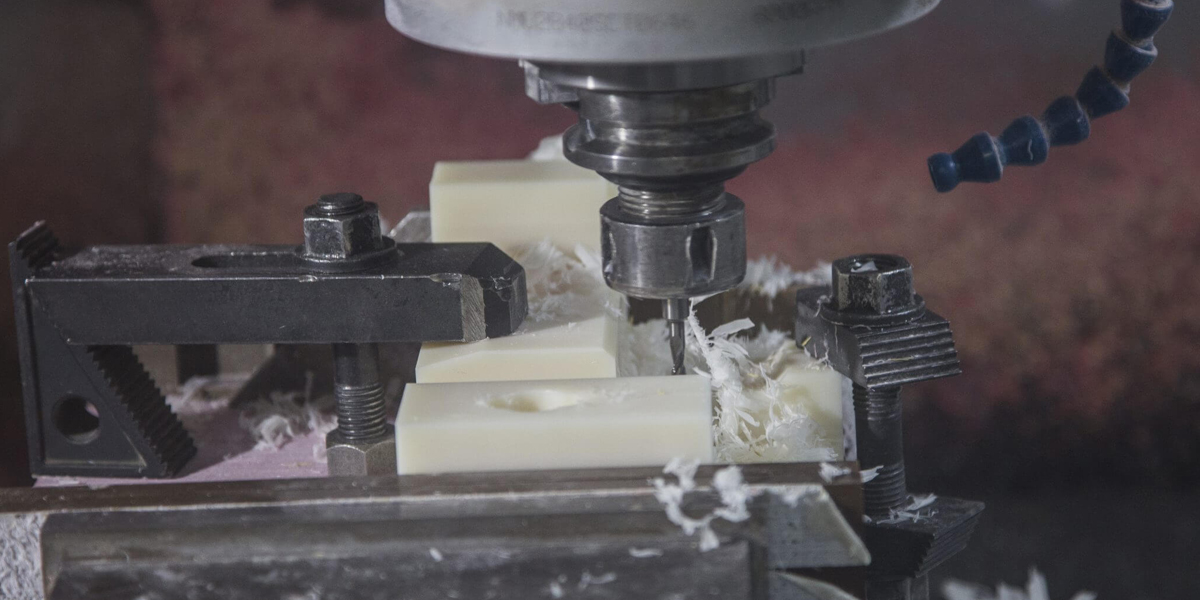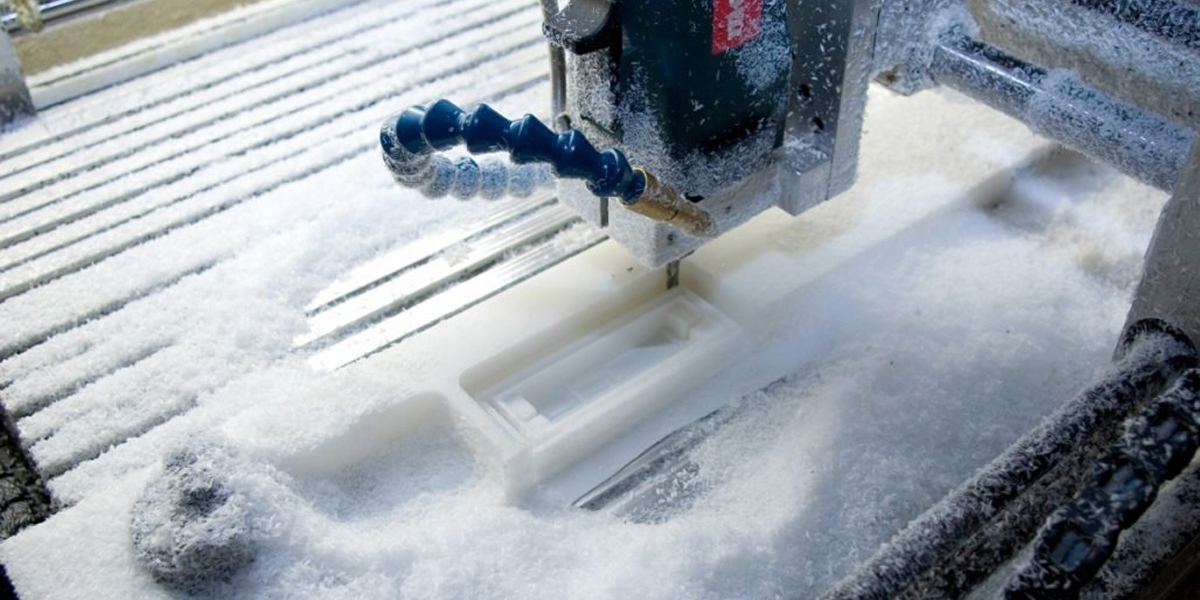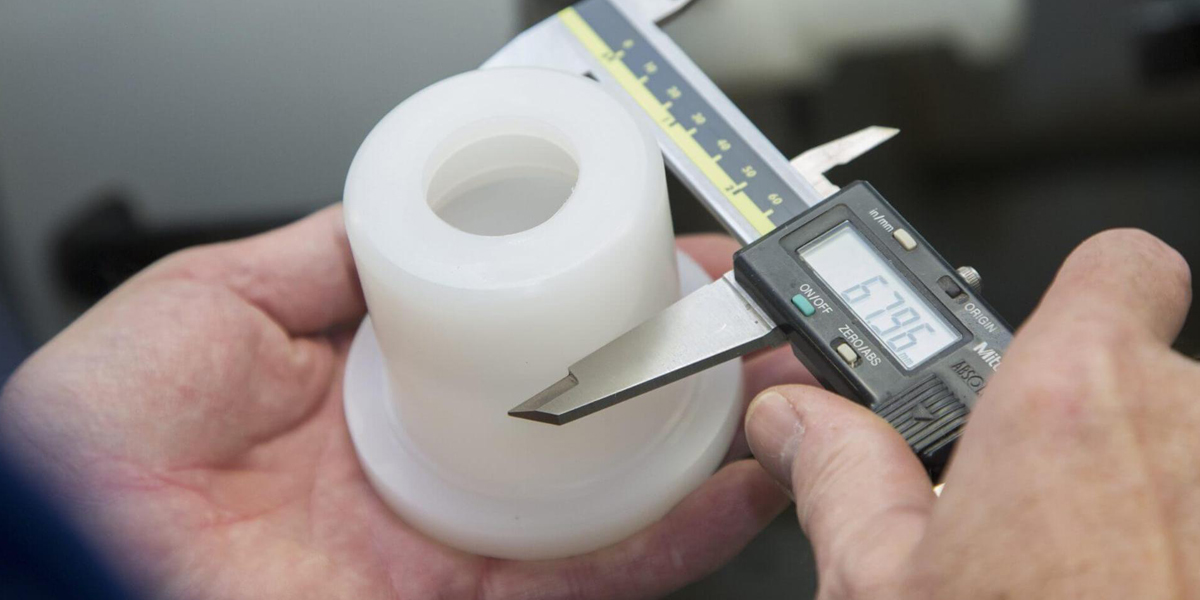Plastics CNC machining refers to the process of using computer numerical control (CNC) machines to shape, cut, or carve plastic materials into precise and complex shapes. CNC machining is a subtractive manufacturing process, meaning it removes material from a plastic workpiece to achieve the desired final shape. This is in contrast to additive manufacturing methods like 3D printing, where material is added layer by layer to build the object.

The process of plastics CNC machining typically involves the following steps:
Design: The first step is to create a 3D model or CAD Computer-Aided Design) file of the desired plastic part or component. This design is then converted into a format that the CNC machine can understand.
CAM Programming: CAM (Computer-Aided Manufacturing) software is used to generate toolpaths and instructions for the CNC machine based on the 3D model. The CAM program determines the cutting paths, tool selection, and other machining parameters.
Material Selection: Various types of plastics can be used for CNC machining, including acrylic, polycarbonate, ABS, nylon, polyethylene, and many others. The selection of the plastic material depends on the specific requirements of the part, such as strength, transparency, chemical resistance, and more.
Setup: The plastic workpiece is securely mounted to the CNC machine's worktable, and the appropriate cutting tools are loaded into the machine's tool changer.
Machining: The CNC machine precisely follows the toolpaths generated by the CAM program, cutting away material from the plastic workpiece until the desired shape is achieved. The process may involve milling, drilling, turning, or other cutting operations, depending on the complexity of the part.
Finishing: After the initial machining is complete, additional processes like sanding, polishing, or painting may be applied to achieve the desired surface finish and appearance.
Plastics CNC machining offers several advantages, including high precision, repeatability, and the ability to create intricate designs. It is commonly used in various industries, such as aerospace, automotive, electronics, medical devices, and consumer goods manufacturing, where precision and quality are crucial.

Material Selection of Plastic CNC machining
Plastics are a group of synthetic or semi-synthetic organic materials known for their malleability, versatility, and wide range of applications. When it comes to CNC machining, different types of plastics can be used, each with its own set of properties and characteristics.
Some common types of plastics used in CNC machining include:
Acrylic (PMMA): Acrylic is a transparent or translucent plastic known for its excellent optical clarity, weather resistance, and ease of machining. It is often used to create displays, signage, lenses, and decorative parts.
Polycarbonate (PC): Polycarbonate is a tough and impact-resistant plastic that also offers good transparency. It is commonly used in applications where high strength and durability are required, such as safety glasses, protective shields, and machine guards.
ABS (Acrylonitrile Butadiene Styrene): ABS is a widely used engineering plastic with good mechanical properties, impact resistance, and machinability. It is commonly used in automotive parts, electronics, and consumer products.
Nylon (Polyamide): Nylon is a strong and durable plastic known for its excellent wear resistance and low friction. It is often used in applications such as gears, bearings, and other mechanical components.
Polyethylene (PE) and Polypropylene (PP): PE and PP are lightweight and chemically resistant plastics commonly used in various industries, including packaging, automotive, and medical.
PTFE (Polytetrafluoroethylene): PTFE, also known by the brand name Teflon, is a non-stick and heat-resistant plastic. It is used in applications where low friction and chemical resistance are essential, such as gaskets and seals.
PVC (Polyvinyl Chloride): PVC is a versatile plastic known for its durability and electrical insulation properties. It finds applications in construction, plumbing, and electrical components.
The choice of plastic material for CNC machining depends on the specific requirements of the part, including mechanical properties, chemical resistance, thermal characteristics, and appearance. Each type of plastic has its own strengths and weaknesses, and the selection is based on the intended application and performance criteria.
It's important to consider factors such as the material's melting point, hardness, flexibility, and how it responds to cutting forces during the CNC machining process. The right choice of material ensures that the final part meets the desired functionality and quality standards.
Advantages of Plastics CNC Machining:
Precision and Accuracy: CNC machines are highly precise and can achieve tight tolerances, resulting in accurate and consistent parts, especially important for intricate designs and complex shapes.
Versatility: Plastics CNC machining is suitable for a wide range of plastic materials, allowing manufacturers to choose from various options based on the desired properties and requirements of the part.
Complexity: CNC machines can create highly complex geometries that may be challenging or impossible to achieve with other manufacturing methods.
Reproducibility: Once a CNC program is created, the same design can be reproduced consistently and accurately, ensuring uniformity in large-scale production.
High-Quality Surface Finish: CNC machining can produce smooth and polished surface finishes, eliminating the need for extensive post-processing in many cases.
Faster Production: CNC machines are capable of high-speed machining, which can reduce production times compared to manual or traditional machining methods.
Design Changes: If design modifications are required, CNC machining allows for relatively easy and quick adjustments to the program without the need for new tooling.
Disadvantages of Plastics CNC Machining:
Initial Setup Costs: The initial investment in CNC machines, tooling, and software can be significant, making it less economical for small production runs.
Material Waste: The subtractive nature of CNC machining means that a significant amount of material is often wasted, especially when machining complex parts.
Limited Material Options: While plastics CNC machining offers versatility, it may not be suitable for certain specialized plastics or materials with extremely high melting points.
Machining Time: The CNC machining process can take longer compared to some other manufacturing methods, particularly for parts with intricate designs or complex geometries.
Tool Wear: Cutting tools used in CNC machining can experience wear and need replacement over time, adding to production costs.
Environmental Impact: Depending on the plastic material used, the CNC machining process can generate plastic chips and dust, potentially leading to environmental concerns if not managed properly.
Skill Requirements: Operating and programming CNC machines require skilled technicians or engineers, which may lead to higher labor costs.
The most common plastics CNC milling operations include:
Profile Milling: Profile milling involves cutting the external or internal contours of a plastic workpiece. This operation is used to create flat surfaces, pockets, slots, and other geometric features.
Pocketing: Pocketing is a type of milling operation that removes material from the interior of a plastic workpiece to create recessed areas or pockets. This is commonly used to create spaces for other components or to reduce the overall weight of the part.
Drilling: Drilling is the process of creating round holes in the plastic workpiece using specialized cutting tools. CNC milling machines can perform various drilling operations, including spot drilling, counterboring, and countersinking.
Facing: Facing is the process of milling the flat surface of a plastic workpiece to achieve a smooth finish or to make it perpendicular to the axis of rotation. It is often done to create parallel faces or to improve the appearance of the part.
Contouring: Contouring involves milling along a specific path to create curved or contoured surfaces on the plastic workpiece. This operation is commonly used to add intricate details or artistic designs to the part.
Engraving: CNC milling machines can perform engraving operations to add text, logos, or decorative patterns onto the surface of the plastic part. This is often used for branding or identification purposes.
Chamfering and Filleting: Chamfering and filleting are milling operations used to create beveled edges or rounded corners on the plastic workpiece. Chamfers and fillets can improve the part's appearance, reduce stress concentrations, and facilitate assembly.
Threading: CNC milling machines can create threads on plastic parts using thread mills or tapping tools. Threaded features are essential for components that require fasteners or for creating a screw-on cap or lid.
Surface Finishing: Surface finishing operations, such as sanding or polishing, can be performed using CNC milling machines to achieve a smoother and more refined surface texture on the plastic part.
Undercutting: Undercutting involves milling away material from the side or bottom of a plastic workpiece, creating recessed areas or complex geometries. This operation is often used in mold making or for parts with intricate features.
Depending on the complexity of the design and the specific requirements of the plastic part, various combinations of these operations may be used to achieve the desired final product. CNC machining offers a versatile and precise method for shaping plastics and is widely used in various industries for producing high-quality plastic components and parts.
Design guidelines of plastic cnc machining
Design guidelines for plastics CNC machining are crucial for ensuring the successful and efficient production of high-quality plastic parts. These guidelines help optimize the CNC machining process, minimize potential issues, and achieve the desired results. Here are some essential design guidelines to consider:
Wall Thickness: Maintain uniform wall thickness throughout the design to promote even cooling and reduce the risk of warping or distortion during machining. Avoid extremely thin or thick sections, as they can lead to challenges in machining and may cause material flow issues.
Fillets and Radii: Incorporate fillets and rounded corners in the design rather than sharp edges. This helps improve the material flow during machining and reduces stress concentrations that could lead to part failure.
Undercuts and Overhangs: Avoid deep undercuts and significant overhangs that may require complex machining setups or additional support structures. Incorporate draft angles to facilitate part ejection from molds or machining fixtures.
Avoid Deep Cuts: Minimize the depth of cuts, especially for softer plastics, to prevent excessive heat generation and potential melting or deformation of the material.
Tolerances: Specify appropriate tolerances based on the capabilities of the CNC machine and the plastic material being used. Tighter tolerances may increase machining time and costs.
Holes and Threads: Use standard hole and thread sizes to take advantage of standard cutting tools. Avoid extremely small holes or threads that may be challenging to machine accurately.
Machining Direction: Discuss the preferred machining direction with the CNC machinist. In some cases, choosing the right cutting direction can improve surface finish and reduce machining time.
Material Considerations: Some plastics generate hazardous fumes during machining. Ensure proper ventilation and use materials with low toxicity or consider alternative machining methods for such plastics.
Prototyping: Consider creating a prototype or a small batch of parts initially to test the design and identify any potential issues before moving to full-scale production.
Design for Post-Processing: If additional finishing processes like polishing, painting, or assembly are required, design the part to facilitate these processes efficiently.
File Formats: Provide the CNC machinist with the design file in a compatible format, such as STEP or IGES, to ensure smooth communication and accurate translation of the design into CNC toolpaths.
Post-processing in plastics CNC machining
Post-processing in plastics CNC machining refers to the additional steps or treatments performed on the machined plastic parts after the primary CNC milling operation is completed. These post-processing steps are often necessary to achieve the desired final appearance, surface finish, or functionality of the part.
Sanding and Polishing: Sanding is used to smooth rough surfaces and remove machining marks, while polishing enhances the part's surface finish, resulting in a glossy appearance. Both techniques improve the aesthetics of the plastic part.
Painting and Coating: Painting and coating can be applied to add color, protect the surface, or improve specific properties like UV resistance or chemical resistance. They can also provide branding or labeling on the part.
Anodizing: Anodizing is an electrochemical process that adds a protective oxide layer to the surface of some specific plastics, such as aluminum. It enhances the part's corrosion resistance and can also add color options.
Assembly: CNC machined plastic parts may require assembly with other components to create a complete product. Post-processing may involve joining, bonding, or fastening these parts together.
Thread Tapping: If threaded features are needed on the plastic part, a post-processing step of thread tapping is performed to create the threads after the primary milling operation.
Deburring: Deburring removes sharp edges or burrs left from the machining process, making the part safer to handle and reducing the risk of injury.
Welding or Joining: In some cases, post-processing may involve welding or joining plastic parts together using various methods like ultrasonic welding or solvent bonding.
Surface Treatment: Surface treatments like texturing or laser etching may be applied to create specific patterns or textures on the plastic part.
Quality Inspection: Post-processing often includes a thorough quality inspection of the machined part to ensure it meets the required specifications and standards.

By following these design guidelines, we can improve the manufacturability of your plastic parts and optimize the CNC machining process to achieve better results, reduced lead times, and cost-effectiveness. Working closely with GD-HUB experienced CNC machinists can also provide valuable insights and recommendations specific to your project's needs.
START NOW.